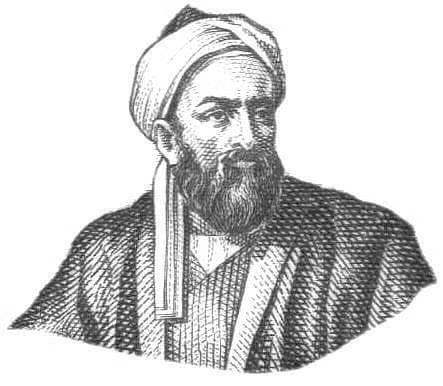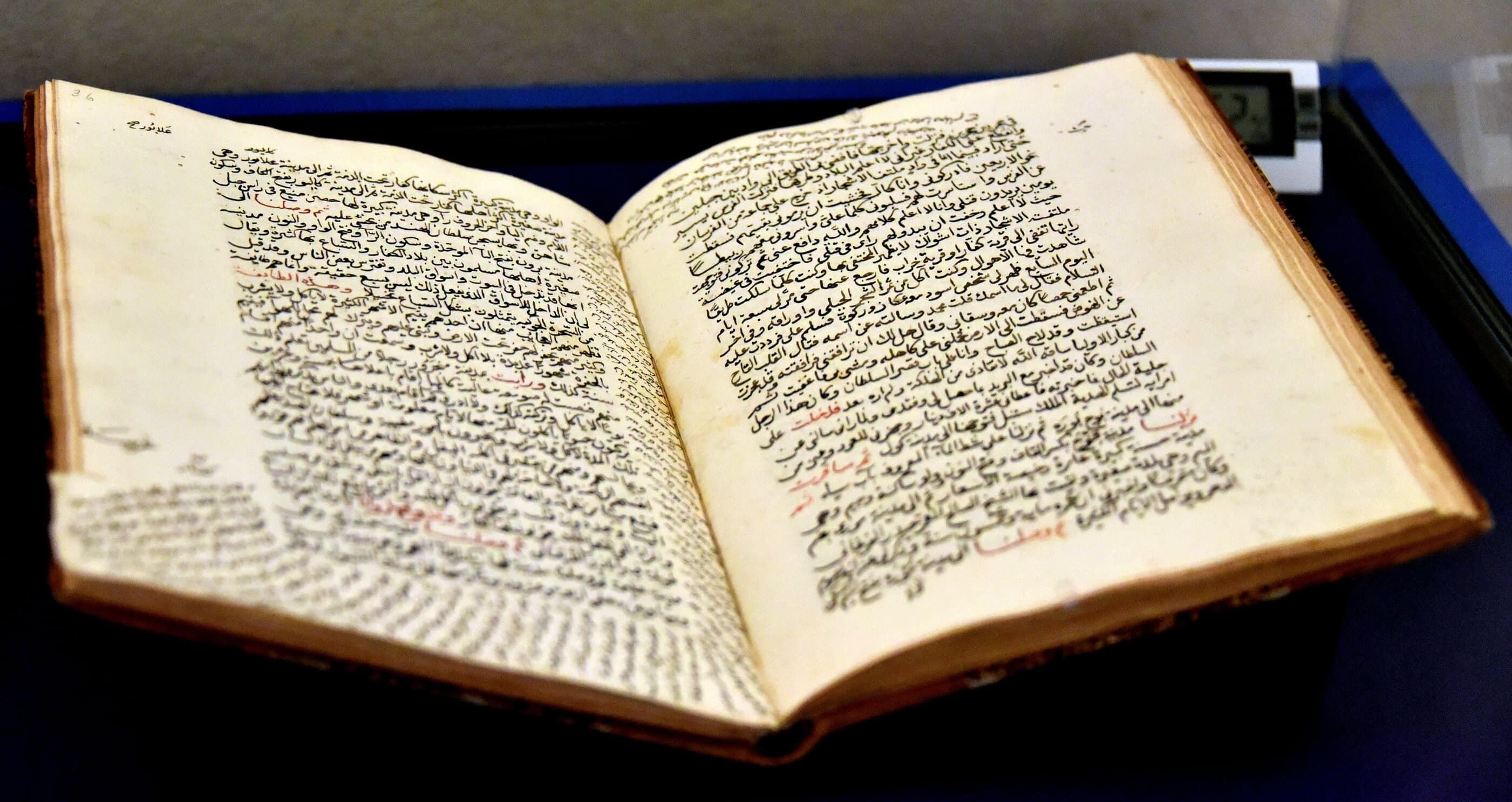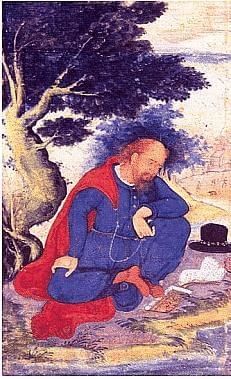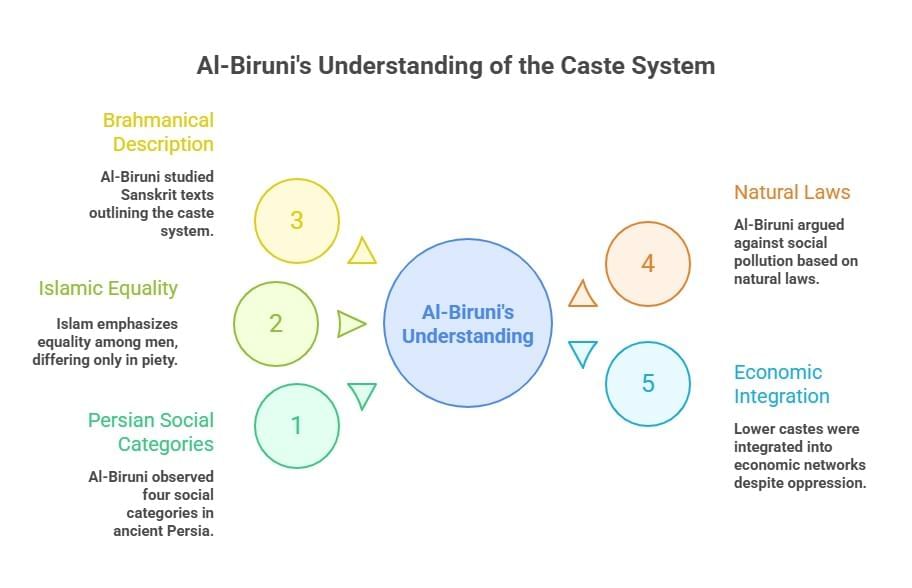Through the Eyes of Travellers Class 12 History
Introduction
Travelers encounter different landscapes, customs, languages, beliefs, and practices in new lands. Women travelers existed, but their accounts are scarce. Surviving accounts of travel vary in subject matter, including court affairs, religious issues, architecture, etc. Some travelers recorded observations within their own lands, focusing on popular customs and traditions. Knowledge of the past can be enriched through descriptions of social life provided by travelers. Three notable travelers are Al-Biruni, Ibn Battuta, and Francois Bernier, who came from different social and cultural backgrounds. The perspectives of travelers make their accounts interesting. The intended audience for these accounts varied.
Al-Biruni and the Kitab-ul-Hind
From Khwarizm to the Punjab
Background and Education
- Al-Biruni, born in 973 in Khwarizm (present-day Uzbekistan), emerged from a region known for its vibrant intellectual atmosphere.
- He received a comprehensive education, mastering several languages such as Syriac, Arabic, Persian, Hebrew, and Sanskrit.
- Despite not knowing Greek, he acquainted himself with the works of Greek philosophers like Plato through Arabic translations.
Relocation to Ghazni
- In 1017, during Sultan Mahmud's invasion of Khwarizm, Al-Biruni, along with other scholars and poets, was taken to Ghazni.
- Initially a hostage, he eventually developed an affinity for the city and spent the rest of his life there.
- Ghazni became a center of cultural exchange, where Al-Biruni's intellectual pursuits flourished.
Interest in India
- Al-Biruni's fascination with India grew during his stay in Ghazni.
- The Ghaznavid empire's expansion into the Punjab facilitated cultural interactions, leading to trust and understanding between the Arab scholars and the local population.
- Al-Biruni immersed himself in the study of Sanskrit, Indian religious and philosophical texts, and spent time with Brahmana priests.
- His extensive travels in the Punjab and northern India contributed to his understanding of the region.
Contribution to Travel Literature
- During Al-Biruni's time, travel literature was an established genre in Arabic literature.
- His experiences in India added a new dimension to this genre, offering insights into Indian culture, religion, and philosophy.
- Although Al-Biruni's works might not have been widely read in India before 1500, they gained traction outside India, contributing to a broader understanding of the subcontinent.
 Al - Biruni
Al - Biruni
The Kitab-ul-Hind
Structure and Contents
- Al-Biruni's Kitab-ul-Hind, written in Arabic, is a comprehensive work divided into 80 chapters.
- It covers a wide array of subjects, including religion, philosophy, festivals, astronomy, alchemy, manners and customs, social life, weights and measures, iconography, laws, and metrology.
- The structure of each chapter is notable, typically beginning with a question, followed by a description based on Sanskritic traditions, and concluding with a comparison with other cultures.
Mathematical Orientation
- Scholars have observed a distinct geometric structure in Al-Biruni's work, characterized by precision and predictability.
- This structure is attributed to his mathematical orientation, reflecting a meticulous approach to presenting information.
Target Audience
- Al-Biruni likely intended his work for people living along the frontiers of the Indian subcontinent.
- His familiarity with translations and adaptations of Sanskrit texts into Arabic suggests an awareness of the existing body of knowledge.
- However, Al-Biruni was critical of the way these texts were written, emphasizing his desire to improve upon them.
 Origin of the term 'Hindu'
Origin of the term 'Hindu'
Ibn Battuta's Rihla
An early globe-trotter
Background and Education
- Ibn Battuta, a Moroccan traveller born in Tangier in the fourteenth century, hailed from a highly respected and educated family known for their expertise in Islamic religious law or shari‘a.
- Following the tradition of his family, he received literary and scholastic education from a young age.
Love for Travel
- Diverging from his contemporaries, Ibn Battuta valued experience gained through travels more than traditional book knowledge.
- His insatiable love for travel led him to explore far-off places and diverse cultures.
- Before his journey to India in 1332-33, he had already embarked on pilgrimage trips to Mecca and extensively traveled in regions such as Syria, Iraq, Persia, Yemen, Oman, and some trading ports along the coast of East Africa.
Journey to India
- Travelling overland through Central Asia, Ibn Battuta reached Sind in 1333.
- Intrigued by the reputation of Sultan Muhammad bin Tughlaq of Delhi, he set off for Delhi, passing through Multan and Uch.
- Impressed by his scholarship, the Sultan appointed him as the qazi or judge of Delhi.
- After some years, a misunderstanding led to Ibn Battuta's imprisonment, but upon clarification, he was restored to imperial service.
- In 1342, he was appointed as the Sultan's envoy to the Mongol ruler in China.
Extensive Travels
- Ibn Battuta's travels took him from the Malabar coast to the Maldives, where he served as the qazi for eighteen months.
- He then proceeded to Sri Lanka, revisited the Malabar coast and the Maldives, and explored Bengal and Assam.
- His journey continued to Sumatra and eventually to the Chinese port town of Zaytun (Quanzhou).
- In China, he traveled extensively, reaching as far as Beijing before deciding to return home in 1347.
Comparison with Marco Polo
- Ibn Battuta's travel account is often compared with that of Marco Polo, who explored China and India in the late thirteenth century.
- Both travellers meticulously recorded their observations about new cultures, peoples, beliefs, and values.
Challenges of 14th-century Travel
- It's crucial to note that Ibn Battuta traveled in the fourteenth century, facing significant challenges compared to modern times.
- The arduous and hazardous nature of travel is emphasized by Ibn Battuta's descriptions, indicating that it took considerable time and posed risks.
- For example, the journey from Multan to Delhi took forty days, and the route from Sind to Delhi took about fifty days.
- The distances covered from Daulatabad to Delhi and from Gwalior to Delhi also required substantial travel time.
 Rihla
Rihla
The “Enjoyment of curiosities”
- Ibn Battuta was an inveterate traveller who spent several years exploring north Africa, West Asia, Central Asia, the Indian subcontinent, and China before returning to Morocco.
- Upon his return, the local ruler issued instructions to record Ibn Battuta's stories, reflecting the fascination and importance attached to the tales of this remarkable globe-trotter.
Francois Bernier: A doctor with a Difference
Portuguese Arrival and Duarte Barbosa
- After the arrival of the Portuguese in India around 1500, a wave of detailed accounts regarding Indian social customs and religious practices emerged.
- Notably, Jesuit Roberto Nobili undertook the translation of Indian texts into European languages.
- Among the prominent Portuguese writers was Duarte Barbosa, who provided a comprehensive account of trade and society in south India.
Post-1600: Dutch, English, and French Travellers
- After the year 1600, a growing number of Dutch, English, and French travellers ventured to India.
- Jean-Baptiste Tavernier, a renowned French jeweller, stands out among them, making at least six trips to India. Tavernier, fascinated with trading conditions, drew comparisons between India, Iran, and the Ottoman Empire.
- Some travellers, like the Italian doctor Manucci, chose not to return to Europe and settled down in India.
François Bernier and the Mughal Empire
- François Bernier, a Frenchman, made a significant impact as a doctor, political philosopher, and historian during his twelve years in India (1656 to 1668).
- He was closely associated with the Mughal court, serving as a physician to Prince Dara Shukoh, the eldest son of Emperor Shah Jahan.
- Later, he became an intellectual and scientist alongside Danishmand Khan, an Armenian noble at the Mughal court.
 François Bernier
François Bernier
Comparing "East" and "West"
- Bernier's extensive travels across India fueled his writings, where he frequently compared the Indian situation to developments in Europe.
- His major work, dedicated to Louis XIV, the king of France, and other works in the form of letters to influential officials and ministers, often portrayed India in a bleak light compared to Europe.
- Despite the accuracy of these assessments being debatable, Bernier's writings gained immense popularity.
Publication and Reception
- Bernier's works were published in France in 1670-71 and were rapidly translated into English, Dutch, German, and Italian within the next five years.
- The popularity of his accounts is evident from the multiple reprints, with the French version being reprinted eight times between 1670 and 1725 and the English version three times by 1684.
- This widespread publication differed significantly from Arabic and Persian accounts, which primarily circulated as manuscripts and were not commonly published before 1800.
Making Sense of an Alien World: Al-Biruni and the Sanskritic Tradition
Overcoming barriers to understanding
- Travellers in the subcontinent faced the challenge of interpreting practices unfamiliar to them.
- Each traveller employed distinct strategies to comprehend their observations. Al-Biruni, for example, acknowledged the inherent difficulties in his task.
- He identified several "barriers" to understanding, with language being the first. According to him, Sanskrit differed significantly from Arabic and Persian, making translation of ideas and concepts challenging.
- The second barrier he identified was the divergence in religious beliefs and practices, and the third was the self-absorption and insularity of the local population.
- Interestingly, despite these challenges, Al-Biruni heavily relied on the works of Brahmanas, frequently citing passages from the Vedas, Puranas, Bhagavad Gita, Patanjali's works, Manusmriti, etc., to gain insight into Indian society.
Al-Biruni’s description of the caste system
- In an effort to explain the caste system, Al-Biruni sought parallels in other societies.
- He observed that ancient Persia recognized four social categories: knights and princes; monks, fire-priests, and lawyers; physicians, astronomers, and other scientists; and peasants and artisans.
- His aim was to suggest that social divisions were not unique to India. Simultaneously, he emphasized that within Islam, all men were considered equal, differing only in their piety.
- Despite accepting the Brahmanical description of the caste system, Al-Biruni disapproved of the notion of pollution inherent in the system.
- He argued that everything impure naturally strives to regain purity, drawing analogies like the sun cleansing the air and salt in the sea preventing water pollution.
- According to him, the concept of social pollution, intrinsic to the caste system, contradicted the laws of nature.
- Al-Biruni's understanding of the caste system was deeply influenced by his study of normative Sanskrit texts, which outlined the system's rules from the Brahmanas' perspective.
- However, he recognized that real-life application often differed, noting instances where categories considered "antyaja" (born outside the system) provided inexpensive labor to peasants and zamindars. Despite social oppression, they were integrated into economic networks.

Ibn Battuta and the Excitement of the Unfamiliar
- By the time Ibn Battuta arrived in Delhi in the fourteenth century, the subcontinent was part of a global network of communication extending from China in the east to north-west Africa and Europe in the west.
- Ibn Battuta himself extensively traversed these lands, visiting sacred shrines, spending time with learned men and rulers, often officiating as qazi, and immersing in the cosmopolitan culture of urban centers where people conversed in Arabic, Persian, Turkish, and other languages, sharing ideas, information, and anecdotes.
- Such stories often highlighted the unfamiliar to leave a lasting impression on the listener or reader about distant yet accessible worlds.
The coconut and the paan
- Ibn Battuta employed unique strategies of representation, particularly evident in his descriptions of the coconut and the paan.
- These plant produce items were entirely unfamiliar to his audience, emphasizing his focus on the exotic and unknown.
Ibn Battuta and Indian cities
- Ibn Battuta discovered that cities in the subcontinent offered exciting opportunities for those with drive, resources, and skills.
- Densely populated and prosperous, these cities, despite occasional disruptions from wars and invasions, featured crowded streets and vibrant markets filled with a diverse array of goods.
- Delhi was described as a vast city with the largest population in India, and Daulatabad in Maharashtra rivaled Delhi in size.
- Bazaars, beyond economic transactions, were the center of social and cultural activities, often hosting public performances.
 Ibn Battuta
Ibn Battuta - While Ibn Battuta did not delve into explaining the prosperity of towns, historians have used his accounts to suggest that towns derived a significant portion of their wealth from the appropriation of surplus from villages.
- The productivity of Indian agriculture, driven by fertile soil enabling two crops a year, contributed to this prosperity.
- The subcontinent was well integrated into inter-Asian networks of trade and commerce, with Indian manufactures in high demand in West Asia and Southeast Asia.
- Textiles, especially cotton cloth, fine muslins, silks, brocade, and satin, were highly sought after, with certain varieties of fine muslin being so expensive that only nobles and the very rich could afford them.
A unique system of communication
- The state took special measures to encourage merchants, providing well-supplied inns and guest houses along trade routes.
- Ibn Battuta was impressed by the efficiency of the postal system, allowing merchants to send information, remit credit, and dispatch goods across long distances.
- The system was so efficient that while it took fifty days to travel from Delhi to Sind, news reports from spies reached the Sultan in just five days through the postal system.
Bernier and the Degenerate East
François Bernier's Perspective
- François Bernier, a French physician and traveler, had a distinct approach compared to other explorers like Ibn Battuta.
- While Ibn Battuta focused on novelty and excitement, Bernier was more concerned with comparing India to Europe, especially France, with a critical lens.
- His objective was to influence policy-makers and intellectuals to make what he deemed as the "right" decisions.
Travels in the Mughal Empire
- Bernier's "Travels in the Mughal Empire" reflects detailed observations, critical insights, and reflections.
- He attempts to place Mughal history within a universal framework by constantly comparing it with contemporary Europe.
- Bernier employs a binary opposition model, presenting India as the inverse of Europe, and hierarchically ordering perceived differences, depicting India as inferior to the Western world.
The Question of Landownership
Bernier noted that a key difference between Mughal India and Europe was the lack of private land ownership in the former. His view was influenced by his strong support for private property and his belief that the Mughal Empire's system of crown land ownership had negative impacts on the economy and society.
Crown Ownership and Its Consequences
- Bernier argues that in the Mughal Empire, the emperor owned all the land, distributing it among nobles.
- This, according to him, resulted in an inability for landholders to pass on their land to their children, discouraging long-term investment in agriculture.
- The absence of private property, as per Bernier, led to the ruin of agriculture, oppression of the peasantry, and a continuous decline in living standards, except for the ruling aristocracy.
Bernier's Critique and its Impact
- Bernier's critique of landownership in Mughal India wasn't unique to him but echoed sentiments found in other travelers' accounts of the sixteenth and seventeenth centuries.
- His views on the negative consequences of crown ownership influenced Western thinkers such as Montesquieu, who developed the concept of oriental despotism, depicting rulers in Asia as having absolute authority and subjects living in conditions of subjugation and poverty.
Influence on Western Theorists
- Bernier's descriptions, particularly his views on landownership, had a lasting impact on Western theorists.
- Montesquieu used Bernier's account to develop the concept of oriental despotism, reinforcing the idea that in Asia, rulers held absolute authority and private property was non-existent.
- Karl Marx later built on this, proposing the concept of the Asiatic mode of production, arguing that in pre-colonial India, surplus was appropriated by the state, leading to a society marked by subjugation and poverty.
Social and Economic Realities in Mughal India
- While Bernier's view of Mughal India presented a stark picture of undifferentiated masses and oppressive rulers, historical documents, such as Abu'l Fazl's account, suggest a different perspective.
- The discrepancy between European travelers' perceptions and Mughal official records raises questions about the accuracy of these portrayals.
- Additionally, the complexity of rural society during the sixteenth and seventeenth centuries challenges the oversimplified view presented by Bernier.
 Abu'l Fazl's Account
Abu'l Fazl's Account
A more complex social reality
While Bernier’s primary focus was on portraying the Mughal state as tyrannical, his descriptions occasionally suggest a more nuanced social reality.
Artisans and State Appropriation
- Despite his overarching narrative of state control, Bernier acknowledged a lack of incentive for artisans to improve the quality of their manufactures as the state appropriated profits.
- This led to a decline in manufactures.
- However, he also noted that India attracted vast quantities of precious metals through the export of manufactures, showcasing a thriving trade aspect.
Prosperous Merchant Community
- Contrary to the image of a solely oppressed society, Bernier recognized the existence of a prosperous merchant community engaged in long-distance exchange.
- Approximately 15 per cent of the population lived in towns during the seventeenth century, a percentage higher than the urban population in Western Europe during the same period.
Mughal Cities: Beyond "Camp Towns"
- Bernier described Mughal cities as "camp towns," suggesting their dependence on the imperial camp for existence and survival.
- He believed these towns lacked viable social and economic foundations, thriving only with imperial patronage.
- However, this portrayal oversimplified the diverse nature of towns in the Mughal Empire.
Diverse Towns
- Towns in the Mughal Empire served various purposes, including manufacturing, trading, ports, sacred centers, and pilgrimage sites.
- Their existence reflected the prosperity of merchant communities and professional classes.
Merchant Communities and Professional Classes
- Merchants played a crucial role in the Mughal economy.
- They often had strong community or kin ties and were organized into caste-cum-occupational bodies.
- In western India, these groups were referred to as mahajans, led by the sheth.
- Urban centers like Ahmedabad had a collective representation of merchants through the nagarsheth.
Diversity of Urban Groups
- Beyond merchants, urban groups included various professional classes such as physicians (hakim or vaid), teachers (pundit or mulla), lawyers (wakil), painters, architects, musicians, and calligraphers.
- While some depended on imperial patronage, many made a living by serving other patrons, and some served ordinary people in crowded markets or bazaars.
Women Slaves, Sati and Labourers
Travellers who documented their experiences in the Indian subcontinent were predominantly men, and their accounts provide insights into the conditions of women. These travellers often observed and sometimes accepted social inequities as a "natural" state of affairs.
Treatment of Slaves
Ibn Battuta's Account
Traveller Ibn Battuta observed that slaves were openly bought and sold in markets, treated as commodities, and exchanged as gifts.
For example, he purchased slaves, along with horses and camels, as gifts for Sultan Muhammad bin Tughlaq.
The Sultan, in turn, rewarded preachers with coins and slaves.
Ibn Battuta's account suggests a significant differentiation among slaves, with some female slaves serving the Sultan as experts in music and dance.
Use of Slaves
- Slaves were primarily employed for domestic labor, and Ibn Battuta found their services indispensable for carrying individuals on palanquins or dola.
- The cost of slaves, especially female slaves for domestic labor, was remarkably low.
- Many families, if financially capable, kept at least one or two slaves.
European Perspectives on Women
Women as a Marker of Cultural Difference
- Contemporary European travellers and writers often emphasized the treatment of women as a crucial marker distinguishing Western and Eastern societies.
- In this context, François Bernier focused on the practice of sati, providing a detailed description.
- He noted the varying attitudes of women towards this practice, with some embracing death willingly and others being compelled.
Sati and Beyond
- While Bernier extensively described sati, he acknowledged that women's lives extended beyond this practice.
- Women played a crucial role in both agricultural and non-agricultural production.
- Those from merchant families actively participated in commercial activities, and in some cases, they even brought mercantile disputes to court.
- This challenges the notion that women were confined solely to the private spaces of their homes.
Summary
In exploring the rich tapestry of historical India through the eyes of diverse travellers such as Al-Biruni, Ibn Battuta, and François Bernier, a multifaceted narrative unfolds. Al-Biruni, driven by intellectual curiosity, transcended linguistic and cultural barriers, offering a comprehensive view of India through his seminal work, the Kitab-ul-Hind. Ibn Battuta, an intrepid globetrotter, brought to life the vibrancy of Indian cities, highlighting the significance of trade, communication, and cultural exchange in the 14th century. François Bernier, with a critical lens, compared India to Europe, notably focusing on landownership and contributing to enduring Western perceptions.
The portrayal of women, slaves, and societal complexities adds depth to the narrative. While travellers observed social inequities, they also uncovered the active roles played by women in various spheres.
Looking at these different perspectives together helps us understand India's past better. It shows why it's important to consider various viewpoints to fully grasp the complexities of historical societies. This approach challenges simple explanations and helps us appreciate India's rich and ever-changing history more deeply.
|
30 videos|274 docs|25 tests
|
FAQs on Through the Eyes of Travellers Class 12 History
| 1. Who was Al-Biruni and what were his contributions to the understanding of India in the Kitab-ul-Hind? |  |
| 2. What is the significance of Ibn Battuta's Rihla in the context of travel literature? |  |
| 3. How did Francois Bernier's perspective differ from that of his contemporaries regarding the East? |  |
| 4. In what ways did Al-Biruni engage with the Sanskritic tradition? |  |
| 5. What social issues related to women, such as slavery and Sati, are discussed in the context of these travelers' writings? |  |






















